
This patient with long-standing insulin-dependent diabetes mellitus has difficulty in closing his hand because the skin is "very tight."
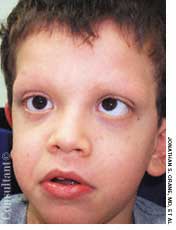

This patient with long-standing insulin-dependent diabetes mellitus has difficulty in closing his hand because the skin is "very tight."

Numerous brown spots on the leg of a man with longstandingdiabetes are diabetic dermopathy. This is amicroangiopathy of the small arterioles of the legs, whichresults in atrophic brown papules.

The atrophic patches on the lower legs of this 47-year-old woman who has haddiabetes mellitus for over 20 years are those of necrobiosis lipoidica diabeticorum.These areas involve degeneration of collagen and elastic fibers in thelower dermis and changes in blood vessel walls. The lesions usually begin assingle or multiple elevated reddish nodules, most commonly in the pretibialarea. Over time, they expand and coalesce into distinctive brownish yellowpatches. These areas may be somewhat tender, but as they spread, theyfrequently become painless-unless they ulcerate. Because the involved skinis fragile, ulcers can form after any minor trauma.
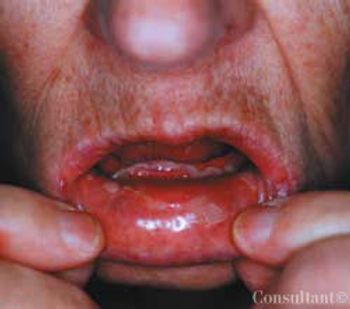
Levofloxacin, 500 mg/d, had been prescribed for a 74-year-old woman who had a urinary tract infection. The patient had type 2 diabetes and hypertension. She was allergic to sulfa drugs. Two hours after taking the first oral dose of the antibiotic, painful blisters developed on the lower lip and soft palate.
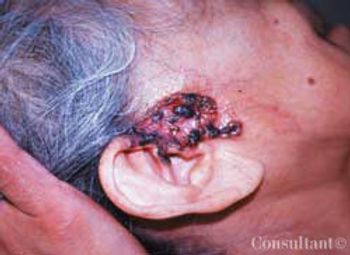
A 75-year-old Hispanic woman presented with a slowly growing, asymptomatic facial lesion of about 3 years’ duration.
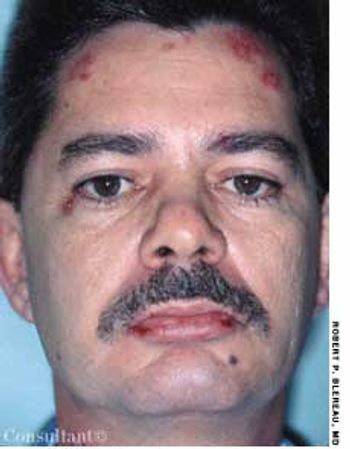
Numerous plaques, some with yellow crusting and central scarring, had erupted primarily on the face and neck of a 46-year-old man. A single lesion had developed on his left elbow as well. The lesions were initially diagnosed as impetigo, but they failed to resolve after 2 courses of oral cephalexin.
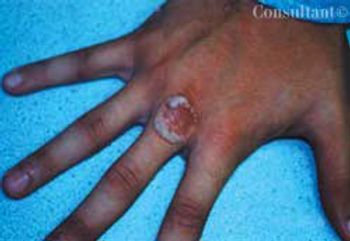
For 3 weeks, a 14-year-old boy had been aware of an enlarging lesion on the back of his hand. He recalled no trauma to the affected area. Further questioning by Dr D. Keith Cobb of Savannah, Ga, revealed that a 4-mm verruca, or wart, had been removed from the same site 6 months earlier with cryosurgery by a different physician.

Concerned about a lesion between her eyes, a 91-year-old woman sought medical evaluation. She had not seen a physician for 23 years. The patient was strong-willed and alert, with no evidence of Alzheimer disease. A huge goiter was evident.
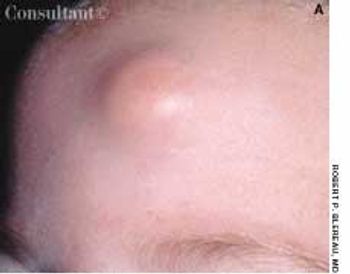
A 0.5-cm mass with overlying erythema on the forehead of a 5-monthold girl was first noticed after she had been hit on the head with a rattle. Excision of the mass was deferred because it was considered to be a hemangioma.
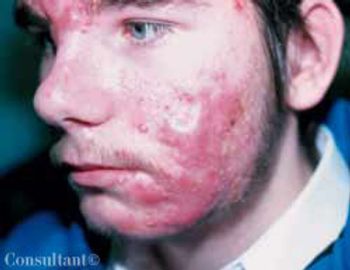
For the past 3 years, comedones, papules, pustules, and nodules had been erupting on the face of a 16-year-old boy. Acne vulgaris had been diagnosed. Topical tetracycline cream and oral tetracycline were used without success.

Painful erosions developed on the sole of a 14-year-old girl's foot several weeksearlier. Within the last few days, the condition has spread to the other sole.The patient is otherwise healthy and takes no medications. She enjoys playingsoccer and has no history of trauma.

Four pink nodules appeared in a linear array on the proximal extensor right forearm of a 77-year-old man. The asymptomatic lesions, which ranged from 0.5 to 1.0 cm in diameter, had been present for 2 months.

Is soaking the feet in an aluminum salt solution an effective therapy fordyshidrosis?

A 49-year-old woman was admitted tothe hospital with a high fever ofabrupt onset, rigor, headache, myalgias,and profound prostration. Hertemperature was 41ºC (105.8ºF);blood pressure, 60/40 mm Hg; respirationrate, 30 breaths per minute;and pulse rate, 130 beats per minute.

A 55-year-old woman had a 10-day historyof a nonproductive cough and apainful rash on both palms for 5 days.The eruption subsequently spreadover her entire body.

A pruritic, erythematous rash developed in a 6-year-oldboy over 5 days. The rash erupted in crops; the lesions appearedinitially as rose-colored macules, progressed rapidlyto papules and vesicles, and finally crusted (A). The distributionof the lesions-with the greatest concentrationon the trunk-is typical of chickenpox.

A generalized pruritic, vesicular eruption on an erythematousbase developed in a 34-year-old man. His palms andsoles were not involved

A 30-year-old man presented with a few-day history of aviral prodrome, including a low-grade fever, mild headache,muscle and joint aches, and malaise, accompaniedby a vesiculopapular rash. The mildly pruritic eruptionbegan on the head and neck and progressed within 36hours to the trunk and proximal extremities; the palmsand soles were spared.

A 40-year-old woman was concerned about an area of redness and tenderness on her left breast. Despite antibiotic therapy prescribed by another physician, the rash had progressed during the past month to erythema and nodules that involved the anterior chest and right breast.

A 65-year-old man with no significant medical history presented with mild abdominal pain-primarily in the left lower quadrant-and bleeding gums. He had a petechial rash over the entire body and hepatosplenomegaly 10 cm below the costal margin.

A 28-year-old white man presented with a recent-onset rash that involved the upper arms.

A 25-year-old black man was intermittently plagued with a mildly pruritic eruption on his chest and back only.

A 37-year-old black man was referred for dermatologic consultation pertaining to a pending legal proceeding.

A 16-year-old high school wrestler developed an acute, pruritic eruption involving both arms and a small portion of the chest.

A recently married 24-year-old black man was brought (reluctantly) by his wife for consultation regarding the perpetual "dirt" on his back.